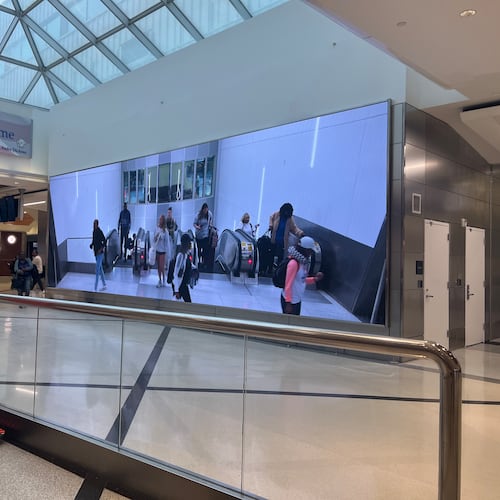Ever flown out of Hartsfield-Jackson International Airport and noticed the posted security wait times didn’t match up with your own experience getting through the checkpoints?
The Atlanta airport uses a sophisticated system that relies on sensors and artificial intelligence to predict how long it will take a traveler to pass through security. But the airport’s use of the expensive system has a few blind spots. And there are a number of factors that can crop up while you wind your way through the terminal that can make the journey through security longer — and sometimes shorter — than expected.
Security wait times have been a major customer service issue at the world’s busiest airport amid a ramp-up in travel since the depths of the pandemic and a recent construction project to upgrade screening equipment at the domestic terminal that reduced capacity at the checkpoints. That year-and-a-half-long project finished earlier this month, just ahead of the peak of the holiday rush, and helped improve capacity after prolonged waits have vexed travelers for months.
Although the airport has a system that comes up with precise wait times to give travelers an idea of what to expect and to help airport officials manage queues, there are some limitations in the airport’s use of the technology.
Credit: arvin.temkar@ajc.com
Credit: arvin.temkar@ajc.com
The system, deployed by Swiss technology company Xovis, uses an array of 3D sensors installed in the ceilings above the security queueing areas at Hartsfield-Jackson. Xovis systems are also used at other airports around the country, including Dallas-Fort Worth, San Francisco, Seattle and New York’s LaGuardia and John F. Kennedy International.
Data collected by the sensors are used in an artificial intelligence network that detects how many people are in line, said Florian Eggenschwiler, Xovis chief product officer. Then, a predictive formula determines how long the wait time would be for someone getting in the back of the queue, based on the inflow and outflow rate, number of open lanes and other factors, he said.
During the heaviest periods, when security lines are longest at the Atlanta airport, lines stretch from the main security checkpoint, through the atrium and into the baggage claim area, where lines of passengers wind between the carousels.
However, the sensors are not installed in the baggage claim area, so the time to wait in the section of the line that winds through baggage claim is not included in the Xovis calculation of the wait times, according to Steve Mayers, assistant general manager for customer experience at Hartsfield-Jackson.
Hartsfield-Jackson has been using the Xovis passenger wait time reporting system for about four years, and when it initially bought the system, “We did not see the need to expand the Xovis system to the baggage claim area because that was not going to be the norm” to have lines extend through there, Mayers said. “We can expand in there if we need to, but I don’t see that as the norm.”
Credit: Steve Schaefer
Credit: Steve Schaefer
Hartsfield-Jackson spokesman Andrew Gobeil said the airport can manually adjust posted wait times to reflect longer waits, which the airport did Tuesday morning when lines stretched into baggage claim and some wait times were more than 70 minutes long.
Mayers added that it’s “a very expensive system” and the sensors currently cover the queueing areas, atrium, the West crossover near where people greet arriving passengers and certain areas of the hallways around the terminal. Hartsfield-Jackson recently renewed the Xovis contract for another three years for about $825,000.
Another factor is that the sensors end at the metal detectors or imaging machines that passengers walk through at the checkpoint, according to Mayers — meaning the security line wait times may not incorporate the full time for baggage to be screened, which can vary —especially with any secondary screening.
And, the wait times do not incorporate the time to recombobulate after passing through security, which may include putting shoes and belts back on, reloading laptops and tablets into bags, putting jackets and backpacks back on.
All that can result in a different “perception of wait time,” Eggenschwiler said.
Some travelers may be most concerned with how long it takes them to get from the curb to the gate to catch their flight — which could also include waiting in line to check bags, walking to the checkpoint, getting through screening, taking the Plane Train and walking to their gate. That means even if the security line takes 30 minutes, it could require much more time to get through the entire airport process before boarding.
Another factor is that the Xovis system calculates estimated wait times based on an average of passengers processed each minute, according to Eggenschwiler.
But as travelers and grocery shoppers all over are aware, different lines can move at a different pace. During the holidays, security lines may take longer because there are more people who don’t travel often and are unfamiliar with security screening rules.
There are also one-off unexpected disruptions that could throw things off, that may not be readily apparent to other people in line.
For example, an average of more than one firearm a day are caught at security checkpoints at Hartsfield-Jackson, with 448 firearms caught in 2022.
When a firearm is detected, the security lane is shut down for police to respond and retrieve the gun. That can slow down screening and increase volume for the remaining open lanes, which could cause wait times to differ from the estimates.
And for checkpoints where there are multiple types of lines such as PreCheck, Clear and Digital ID at the South checkpoint, the wait time posted is “just the average of the wait times at that particular checkpoint,” Mayers said.
Credit: arvin.temkar@ajc.com
Credit: arvin.temkar@ajc.com
Combined, all of these factors mean some passengers’ actual wait times to get through security lines and screening and on their way to their gate may be significantly longer than the posted wait times on the airport’s website.
Mayers said when wait times are particularly long, airport officials try to “speak with the public through social media” to advise travelers to get to the airport early. If the wait times are going up, from 45 minutes to an hour, travelers should “add some additional time,” he said. “At any point there could be an increase in the wait times.”
That’s partly because the factors that drive security lines are complex.
“It’s really interesting, the science (of) these airport queues,” Eggenschwiler said. “That’s why we’re so obsessed with them.”
Over the year-end holiday travel season, airport officials have been advising travelers to get to the airport 2.5 to 3 hours before their flights, while Delta officials have been telling customers to get to the airport at least 3 hours early.
Before using the Xovis system, the airport had previously estimated wait time ranges manually and posted them in the terminal. Mayers said in 2024, the airport plans to post wait times on digital displays in the domestic terminal using the Xovis data.
About the Author
The Latest
Featured



